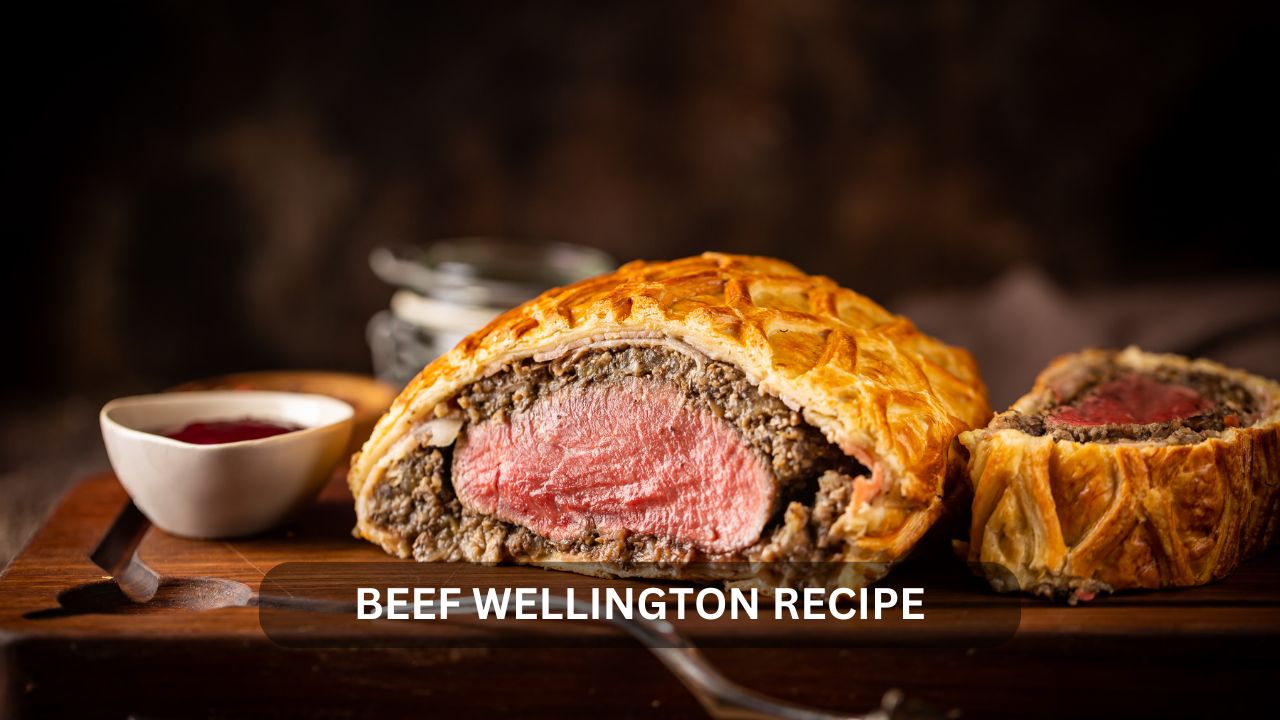It’s a dish that resonates with the heart and soul of classic cuisine—a rich crescendo of flavors wrapped in golden layers of pastry. Beef wellington recipe is heralded as an iconic masterpiece, praised in Michelin-starred restaurants and endeared to home cooks craving a challenge. This sumptuous dish is a composite of culinary arts—meat cooked to perfection, a layer of rich duxelles, and a blanket of puff pastry that crisply melts in your mouth. In this all-encompassing guide, we encapsulate the essence of Beef Wellington, providing you with every detail to craft this formidable feast right in your kitchen.
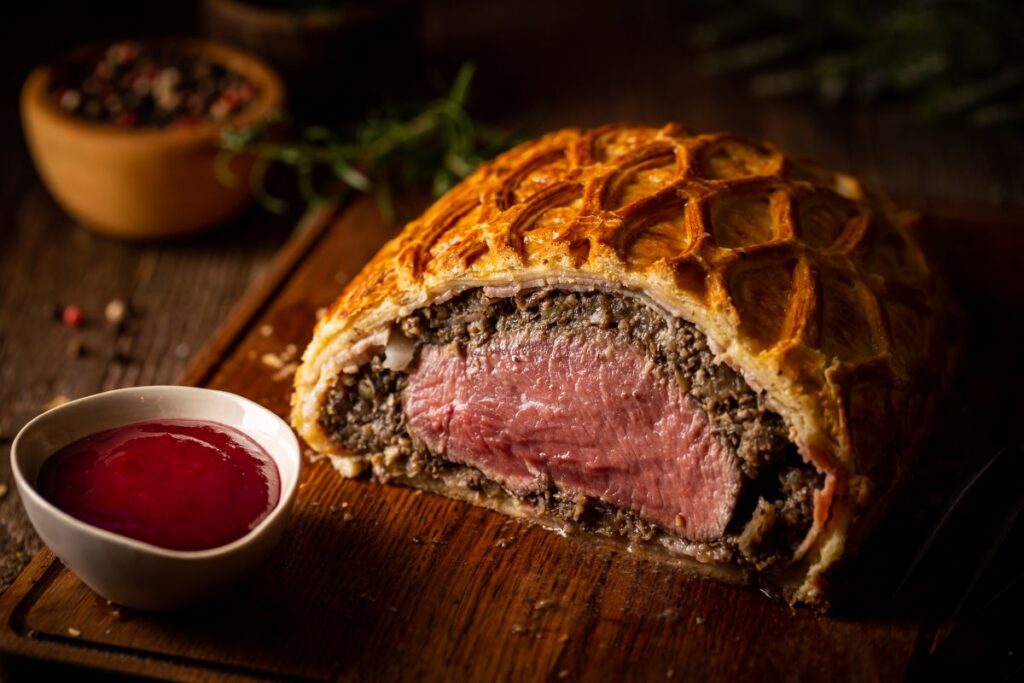
1. Beef wellington recipe: Understanding the Classics
Beef wellington recipe storied past adds an alluring mystique to its exquisite present. Originally named after the Duke of Wellington, who famously defeated Napoleon at Waterloo, this historical connotation elevates its status. However, its origins are likely less grand and more grounded in the practicality of preserving meat with pastry in the 19th century. Fast forward to today, it is an aspirational main course for celebratory meals and a milestone for many to conquer in their culinary adventures.
The Anatomy of a Wellington
At its heart, Beef Wellington consists of four key components:
- A center-stage cut of beef, traditionally a tenderloin, though modern interpretations may showcase ribeye or sirloin.
- Duxelles, a finely chopped mixture of mushrooms, shallots, and herbs—often blended to a paste.
- Parma ham, which envelops the meat to insulate it from the pastry and enhance its flavor.
- Puff pastry, the pièce de résistance, which encases the entire ensemble before baking to golden perfection.
2. Selecting the Star of the Show: The Perfect Cut of Beef
The quality of the beef is paramount, as it is both the centerpiece and the flavor foundation of your Wellington. A tenderloin offers the supreme, melt-in-your-mouth experience, but ribeye affords a richer, more robust flavor. Ensure your cut is of the highest quality and properly prepared.
Finding the Right Cut
A whole Chateaubriand cut or center-cut beef tenderloin is the traditional choice, but you can also opt for filet mignon if serving smaller portions. Aim for a uniform thickness to ensure even cooking.
Preparation and Presentation
Trim the silver skin and any excess fat from the beef, but be mindful to leave some to preserve moisture and impart flavor. Treat the cut with reverence during preparation; a Wellington is only as good as the beef at its core.
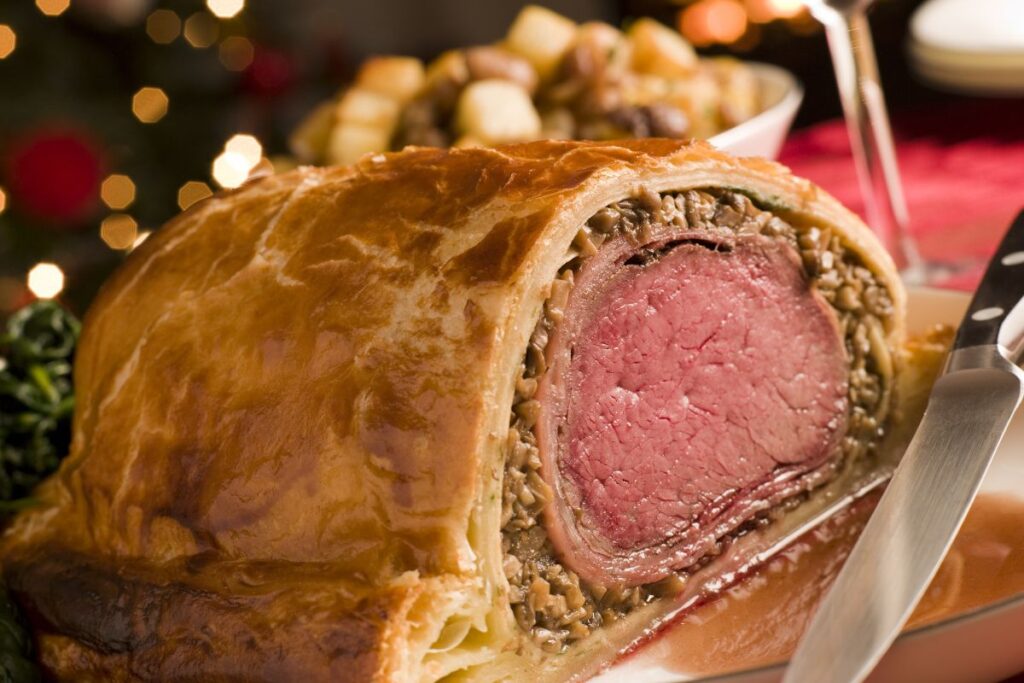
3. The Heart of the Matter: Crafting the Perfect Duxelles
Duxelles is the unsung hero, contributing a complex umami depth essential to the dish. It not only complements the beef but also acts as a moisture barrier to the pastry, preventing it from becoming soggy.
Making Duxelles at Home
Begin with finely chopping mushrooms, preferably a mix of cremini and porcini for a robust flavor. Combine these with minced shallots and fresh thyme, then slowly cook them down to evaporate all moisture. The resulting paste should be rich and aromatic, ready to elevate the Wellington experience.
4. The Art of Puff Pastry
The pastry in beef wellington recipe is more than a mere vessel—it’s a defining feature, requiring patience and precision to achieve that sought-after flaky, golden crust.
Making or Choosing the Right Puff Pastry
You have the option to choose store-bought all-butter puff pastry, which offers a convenient and scrumptious alternative for those looking to save time in the kitchen. This choice promises a delightful taste and a flaky texture that can elevate any dish. However, for the culinary purists who revel in the art of baking, mastering the craft of homemade puff pastry is a deeply gratifying endeavor. The process, though time-consuming and requiring a level of precision, results in a puff pastry of unparalleled texture and taste, far surpassing what you can find pre-made in stores. Engaging in this culinary challenge not only enhances your baking skills but also allows for a more personalized touch to your dishes.
Handling and Rolling
The key to a perfect pastry is to keep it cold and work quickly. After rolling, it should be no thicker than a 1/4 of an inch to ensure it bakes evenly with the meat.
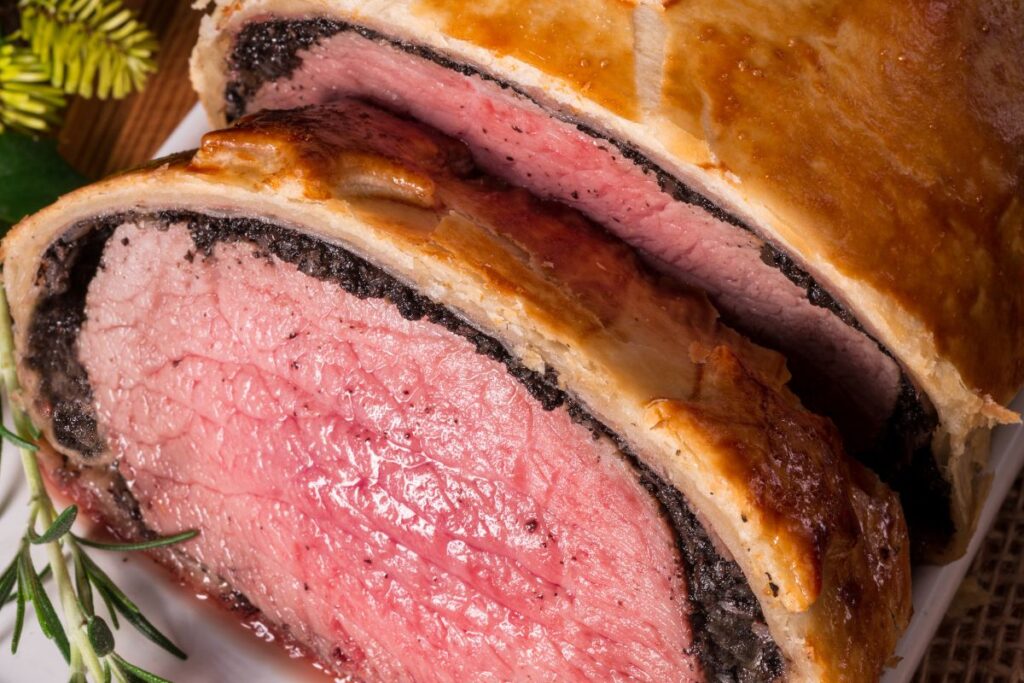
5. The Grand Assembly: Crafting Your Wellington
With the individual components ready, it’s time to bring them together in a symphony of flavor, texture, and technique.
Layering with Parma Ham and Duxelles
When preparing the dish, it’s crucial to evenly spread the layers of Parma ham and duxelles. This technique is not only essential for distributing the flavors throughout the dish but also plays a critical role in protecting the pastry. By creating a barrier, the ham and duxelles prevent excess moisture from seeping into the pastry, ensuring that it remains perfectly crisp and flaky. This attention to detail can significantly enhance the overall quality and taste of the dish.
Maintaining Symmetry and Structure
Wrapping the beef tightly in cling film is a crucial step that aids in maintaining its cylindrical shape during the cooking process. This technique ensures that the beef cooks evenly and retains its juices, enhancing the overall flavor of the dish. When it comes to encasing the beef in puff pastry, a similar level of delicacy and precision is required as when one is wrapping a delicate present. The goal is to envelop the beef gently with the pastry, making sure the edges are meticulously sealed. This seam should be as airtight as possible, which is essential to prevent any juices from escaping and to maintain the pastry’s integrity and flakiness during the baking process. Achieving this seal not only helps in creating a visually appealing dish but also plays a vital role in the textural contrast between the tender beef and the crisp, golden pastry that is so characteristic of this dish.
6. The Path to Perfection: Cooking Your Wellington
The cooking process is where skill meets precision, determining whether the beef will be succulent or overdone.
Oven Toil and the Big Reveal
Begin by preheating your oven to a piping hot 200°C (400°F), setting the stage for a perfect bake. Place the Wellington on the middle rack, ensuring it’s perfectly positioned for even cooking. It’s crucial to keep the oven door firmly shut for the first 15 minutes of baking. This step is key to ensuring the pastry sets properly, trapping the heat inside to create that perfect, flaky texture without any heat escaping.
Calculating Cooking Times
To achieve the perfect medium-rare beef wellington recipe, you should aim for an approximate cooking time of 20 minutes. If you prefer your Wellington a bit more done, extend the cooking time to around 25 minutes. For the best results and to ensure your meat reaches the ideal internal temperature, utilizing a meat thermometer is crucial. Aim for 120°F if you’re targeting a medium-rare doneness and 130°F for a medium cook. It’s also important to remember that the resting period is an essential step in the process. After removing your Wellington from the oven, let it rest for a while. During this time, the meat will continue to cook slightly due to the residual heat trapped within the pastry crust, ensuring a juicy, perfectly cooked result every time.
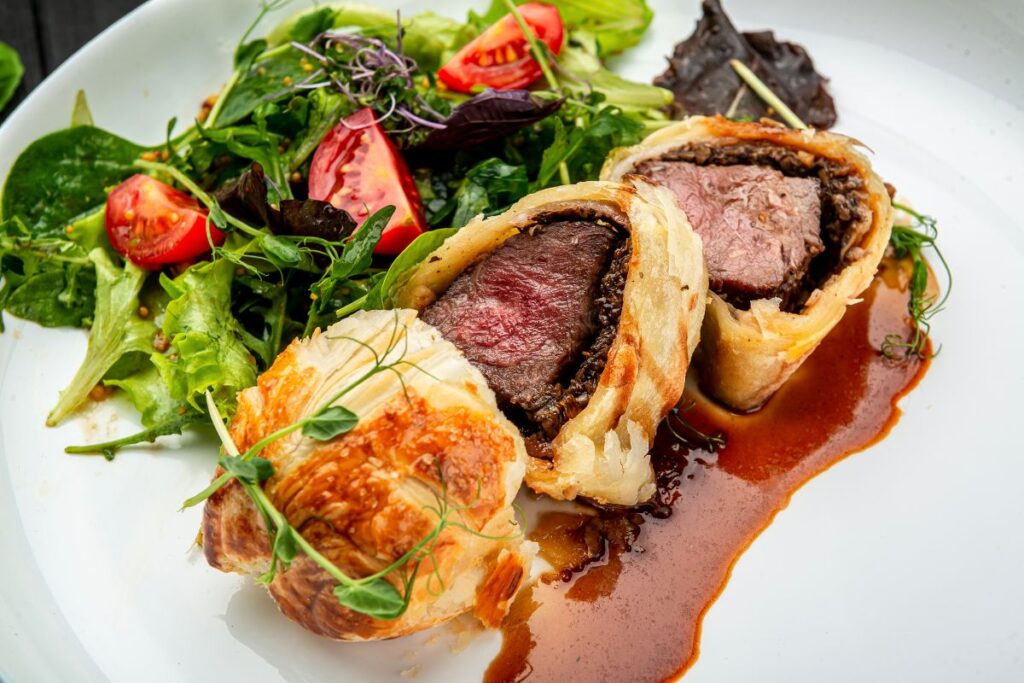
7. Unveiling Variations: Creative Beef Wellington Recipes
While the classic Wellington is a sight to behold, you can breathe new life into this timeless recipe with your own creative twists.
Filling the Space with Imagination
Experiment with different flavor profiles to elevate your culinary creations. Consider adding the bold taste of blue cheese, the luxurious touch of truffle oil, or even a decadent layer of foie gras for an unforgettable flavor experience. For those seeking non-meat options, consider the rich, earthy taste of portobello mushrooms or the sweet, nutty flavor of butternut squash. These ingredients can create hearty and delectable alternatives that are sure to impress.
Dietary Reinterpretations
For individuals managing dietary restrictions, opting for a filo pastry can provide a lighter, gluten-free alternative that doesn’t sacrifice flavor or texture. This choice is particularly appealing for those seeking to enjoy traditional dishes without the gluten. Alternatively, for those embracing a pescatarian diet or simply looking to diversify their culinary experiences, consider preparing a salmon Wellington. This dish, featuring a succulent salmon fillet wrapped in pastry, along with spinach and the creamy, herbed taste of Boursin cheese, offers a delightful twist on the classic Wellington, expanding your culinary horizons with its unique blend of flavors.
Beef Wellington Recipe
Course: DinnerCuisine: EnglandDifficulty: Easy4
servings1
minute1
minute427
kcalIt’s a dish that resonates with the heart and soul of classic cuisine—a rich crescendo of flavors wrapped in golden layers of pastry. Beef wellington recipe is heralded as an iconic masterpiece, praised in Michelin-starred restaurants and endeared to home cooks craving a challenge. This sumptuous dish is a composite of culinary arts—meat cooked to perfection, a layer of rich duxelles, and a blanket of puff pastry that crisply melts in your mouth. In this all-encompassing guide, we encapsulate the essence of Beef Wellington, providing you with every detail to craft this formidable feast right in your kitchen.
Ingredients
1.5 kg (approx. 3.3 lbs) beef tenderloin, trimmed
Sea salt and freshly ground black pepper, to taste
2 tbsp olive oil, for searing
English mustard, for brushing (optional)
250g (approx. 8.8oz) mushrooms
4 tbsp unsalted butter
2 shallots, minced
2 cloves garlic, minced
1 sprig fresh thyme, leaves only
100ml (approx. 3.4 fl oz) dry white wine
10-12 slices of Parma ham (or prosciutto)
Flour, for dusting
500g (approx. 1.1 lbs) puff pastry, rolled out
2 egg yolks, beaten (for the egg wash)
Directions
- Prepare the Beef: Season the beef tenderloin generously with salt and pepper. Heat a skillet with olive oil over high heat. Sear the beef on all sides until golden brown, about 2-3 minutes per side. Remove from heat, brush all over with Dijon mustard, and allow to cool completely.
- Make the Duxelles: In a large pan, melt butter over medium heat. Add shallots and garlic, cooking until softened. Add the finely chopped mushrooms, thyme, salt, and pepper. Cook until mushrooms are golden and all moisture has evaporated. Stir in white wine, cooking until the mixture is dry. Set aside to cool.
- Wrap the Beef: Lay out the Parma ham on a piece of cling film, slightly overlapping, to form a rectangle. Spread the duxelles evenly over the ham. Place the cooled beef at the bottom of the rectangle and roll tightly using the cling film to form a log. Chill in the refrigerator for 15 minutes.
- Prepare the Pastry: Dust the work surface with flour and roll out the puff pastry to a rectangle large enough to encase the beef. Unwrap the beef from the cling film and place it in the center of the pastry. Fold the pastry around the beef, cutting off any excess dough, and seal the edges. Brush the entire surface with the egg wash. Chill for 10 minutes.
- Bake: Preheat your oven to 425°F (220°C). Place the wrapped beef seam-side down on a baking sheet lined with parchment paper. Score the top of the pastry lightly with a knife, avoiding cutting through it. Brush with another layer of egg wash. Bake for 20-25 minutes, or until the pastry is golden brown and puffed.
- Rest and Serve: Remove the Wellington from the oven and allow it to rest for 10 minutes before slicing. This rest period is crucial for the meat to retain its juiciness. Slice into thick portions and serve while hot, garnished with fresh herbs if desired.
Recipe Video
For more delicious homemade cook recipes, check out here-
- How to Cook Homemade Chicken Noodle Soup Recipe
- How to Cook Air Fryer Steak with Garlic-Herb Butter Recipe
- How to Cook How to Cook Perfect Scallops Recipe
- How to Cook Filet Mignon Recipe
- How to Cook Stir Fried Tomato and Egg Recipe
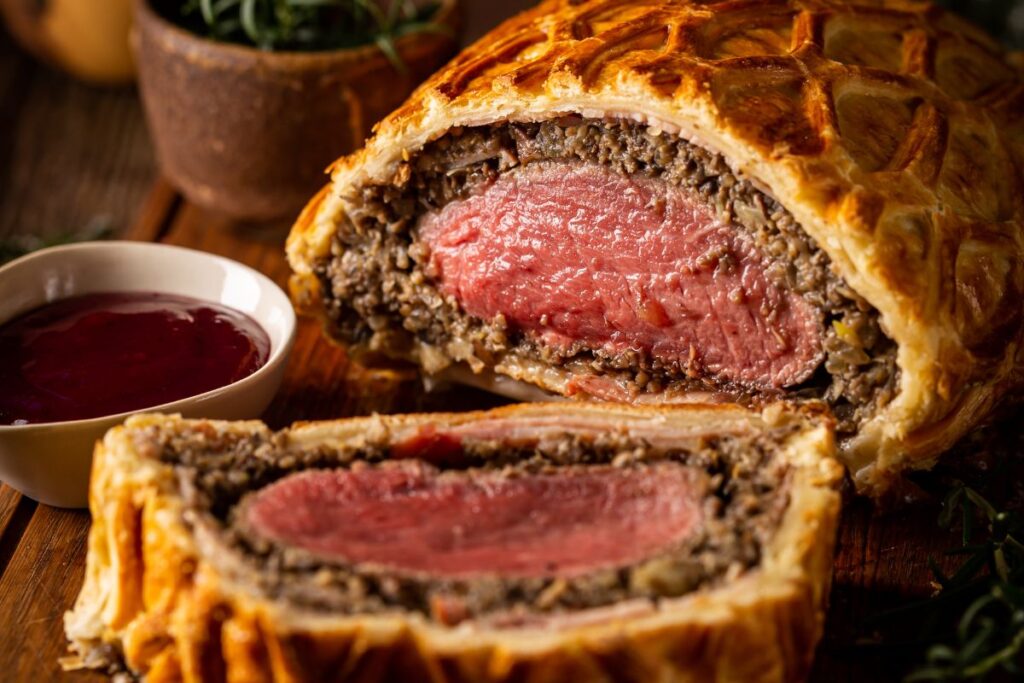
8. Conclusion: The Gateway to Gourmet at Home
In conclusion, beef wellington recipe is more than just a dish—it’s a declaration of culinary prowess and a testament to the joy found in the sphere of the kitchen. For those willing to invest the time and effort, the rewards of a beautifully executed Wellington are immeasurable.
Through understanding the foundations of this classic recipe, experimenting with personal touches, and sharing your masterpieces, you not only expand your gastronomic repertoire but also forge a deeper connection to the craft of cooking. Whether you serve it at a celebration or simply as an homage to your love of culinary excellence, a well-done beef wellington recipe signifies a mastery few dishes can match.
In your culinary voyage, remember that each attempt is a step towards your own personal perfection. And just as every Wellington has a story, so too will yours—in the sizzling of meat, the aroma of herbs, and the warmth of a golden crust. Begin your Wellington adventure today, and savor the artistry of this culinary classic. Bon appétit! # No termination phrase needed as this content is still discussing and providing information on the topic of beef wellington recipe. The possibilities for creativity and experimentation with this dish are endless, making it a timeless staple in any culinary repertoire. Keep exploring and discovering new ways to elevate this classic recipe, and share your passion for cooking with others by proudly serving your well-crafted beef wellington recipe. Happy cooking! # No termination phrase needed as this content is still discussing and providing information on the topic of beef wellington recipe. Let your creativity and culinary skills shine by trying unique flavor combinations and variations on this timeless dish. Don’t be afraid to experiment and make it your own, while also honoring the traditional techniques that make a perfect Beef Wellington.
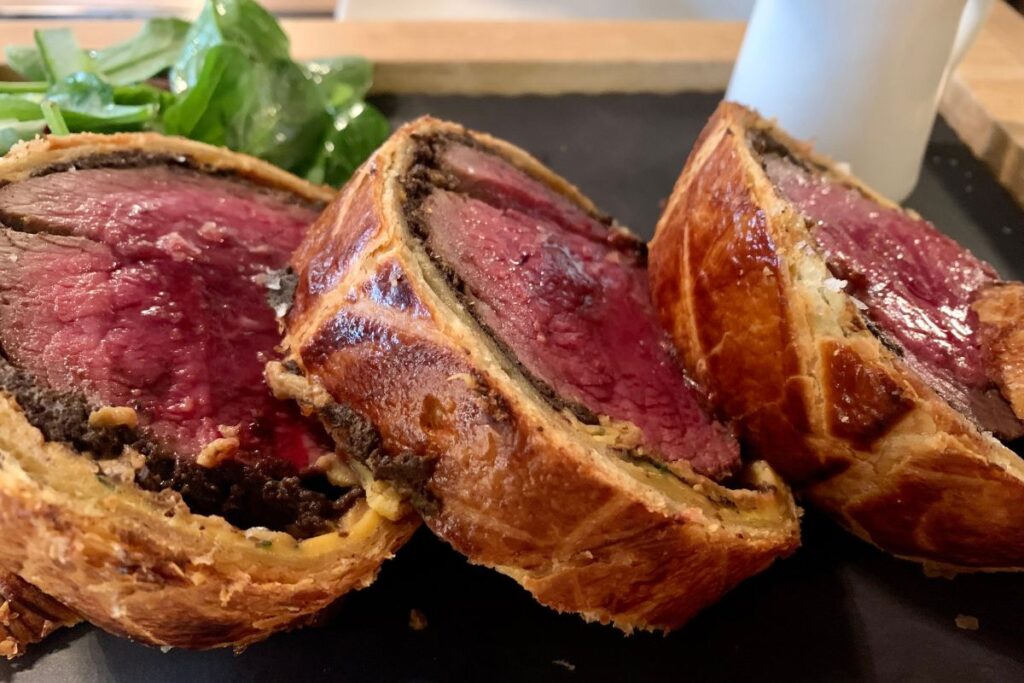
References
Beef Wellington is The Most Impressive Main Dish You’ll Ever Make
Frequently Asked Questions about Beef Wellington
Can Beef Wellington be prepared in advance?
Yes, Beef Wellington can be prepared in advance up to the baking step. You can assemble it, wrap it tightly in cling film, and refrigerate for up to 24 hours. Remember to remove it from the fridge at least an hour before baking to ensure it cooks evenly.
What’s the best way to ensure the puff pastry doesn’t get soggy?
To prevent the puff pastry from becoming soggy, make sure your duxelles and any other fillings are cooled and as moisture-free as possible before assembling. The layers of Parma ham also act as a barrier to keep the moisture away from the pastry.
How do I achieve a perfectly cooked beef tenderloin inside the pastry?
The key is to sear the beef tenderloin before the assembly to lock in the flavors and juices and then baking the assembled Wellington at the right temperature and time. Using a meat thermometer will help you monitor the internal temperature to achieve your preferred doneness.
Can Beef Wellington be made with other meats or vegetarian alternatives?
Absolutely! While traditional Beef Wellington is made with beef tenderloin, you can experiment with alternative fillings such as lamb, pork tenderloin, or even salmon for a pescatarian version. Portobello mushrooms or a mixture of lentils and veggies can provide delicious vegetarian alternatives.
What accompaniments work well with Beef Wellington?
Beef Wellington pairs beautifully with a range of side dishes. Popular options include roasted vegetables, mashed potatoes, pureed parsnips, or a simple green salad. For sauces, a red wine reduction or a rich Madeira sauce complements the dish exquisitely. Get creative and find the perfect combination of sides to elevate your Beef Wellington experience.

